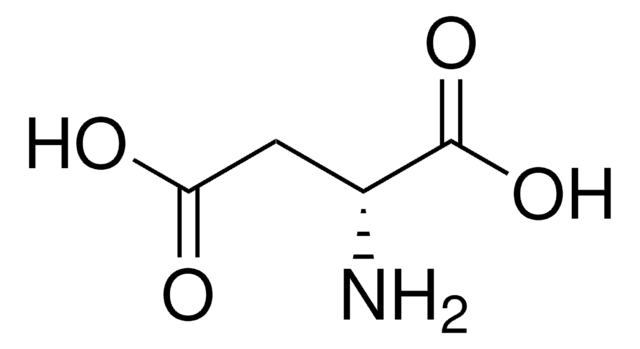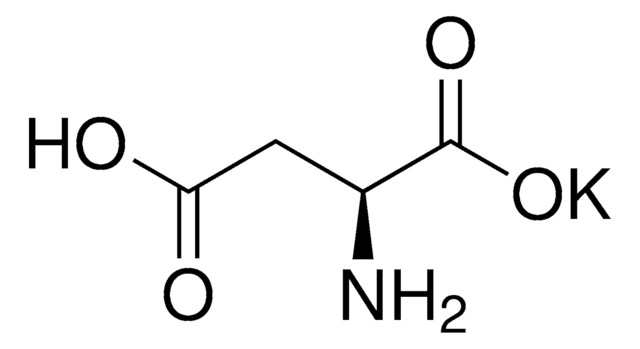Kluczowe dokumenty
A8949
L-Aspartic acid
≥99% (HPLC), BioXtra
Synonim(y):
(S)-(+)-Aminosuccinic acid, (S)-Aminobutanedioic acid
About This Item
Polecane produkty
Nazwa produktu
L-Aspartic acid, BioXtra, ≥99% (HPLC)
linia produktu
BioXtra
Poziom jakości
Próba
≥99% (HPLC)
Formularz
powder
zanieczyszczenia
≤0.0005% Phosphorus (P)
≤0.1% Insoluble matter
pozostałość po prażeniu
≤0.1%
kolor
white to off-white
mp
>300 °C (dec.) (lit.)
rozpuszczalność
1 M HCl: 0.5 M, clear, colorless
ślady anionów
chloride (Cl-): ≤0.05%
sulfate (SO42-): ≤0.05%
ślady kationów
Al: ≤0.0005%
Ca: ≤0.001%
Cu: ≤0.0005%
Fe: ≤0.0005%
K: ≤0.005%
Mg: ≤0.0005%
NH4+: ≤0.05%
Na: ≤0.005%
Pb: ≤0.001%
Zn: ≤0.0005%
ciąg SMILES
N[C@@H](CC(O)=O)C(O)=O
InChI
1S/C4H7NO4/c5-2(4(8)9)1-3(6)7/h2H,1,5H2,(H,6,7)(H,8,9)/t2-/m0/s1
Klucz InChI
CKLJMWTZIZZHCS-REOHCLBHSA-N
informacje o genach
human ... CA1(759) , CA2(760)
rat ... Grin2a(24409)
Szukasz podobnych produktów? Odwiedź Przewodnik dotyczący porównywania produktów
Zastosowanie
- Metabolomics Analysis Identifies Differential Metabolites as Biomarkers for Acute Myocardial Infarction.: Research identifies key metabolites, including L-Aspartic acid, involved in the metabolic pathways affected during acute myocardial infarction. This study enhances the understanding of biochemical changes during heart attacks, potentially leading to better diagnostic markers (Zhou et al., 2024).
Działania biochem./fizjol.
Kod klasy składowania
11 - Combustible Solids
Klasa zagrożenia wodnego (WGK)
WGK 1
Temperatura zapłonu (°F)
Not applicable
Temperatura zapłonu (°C)
Not applicable
Środki ochrony indywidualnej
dust mask type N95 (US), Eyeshields, Gloves
Wybierz jedną z najnowszych wersji:
Masz już ten produkt?
Dokumenty związane z niedawno zakupionymi produktami zostały zamieszczone w Bibliotece dokumentów.
Klienci oglądali również te produkty
Chromatograms
application for HPLCapplication for HPLCNasz zespół naukowców ma doświadczenie we wszystkich obszarach badań, w tym w naukach przyrodniczych, materiałoznawstwie, syntezie chemicznej, chromatografii, analityce i wielu innych dziedzinach.
Skontaktuj się z zespołem ds. pomocy technicznej





